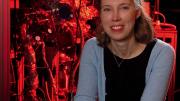Growing up in Lutheran Sweden, Karin Öberg had no inkling that she would one day become an astrochemist, the first to observe a complex organic molecule in the freezing cloud of gas and dust surrounding a young star—or that she would convert to Catholicism. As a young student, she was interested in literature, history, and art; and it was philosophical questions about “who we are, where we come from” and the origins of the universe that made her think, as she neared college and decided to pursue science, that physics and astronomy were the most interesting fields to study. But in the competitive environment at Caltech, she learned her aptitude was for chemistry: “I had to choose. Do I go with my heart, or my talent?” She chose chemistry, before discovering she could apply that talent to important questions in astrophysics. One such big question is, Are the chemical antecedents of life present outside the solar system? To explore this, Öberg, professor of astronomy, studies ice chemistry in her lab. “The clouds where stars and planetary systems form are close to absolute zero,” she says. “If a molecule hits a grain of dust, it will stick and form an ice made of water, dry ice, or [carbon monoxide]. Any chemistry is going to happen either on top of this icy layer or inside the ice.” The James Webb Space Telescope now enables her to study the composition of these icy grains among the inner regions of distant solar systems, where Earth-like planets form in the “habitable zone.” Could the precursors of life exist there? Some questions only science can answer, with others better suited to theology. Whether intelligent life exists elsewhere, she says, is a question on which both her science and religion are currently “agnostic.”
Karin Öberg
Karin Öberg
This astrochemist studies the chemical antecedents of life in the universe.

Karin ÖbergPhotograph by Stu Rosner
You might also like
Eating for the Holidays, the Planet, and Your Heart
“Sustainable eating,” and healthy recipes you can prepare for the holidays.
Getting to Mars (for Real)
Humans have been dreaming of living on the Red Planet for decades. Harvard researchers are on the case.
Why Humans Walk on Two Legs
Research highlights our evolutionary ancestors’ unique pelvis.
Most popular
Explore More From Current Issue

The Trouble with Sidechat
No one feels responsible for what happens on Harvard’s anonymous social media app.

Mount Vernon, Historic Preservation, and American Politics
Anne Neal Petri promotes George Washington and historic literacy.

Novelist Lev Grossman on Why Fantasy Isn’t About Escapism
The Magicians author discusses his influences, from Harvard to King Arthur to Tolkien.





